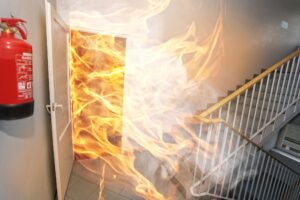The most powerful weapon in a firefighter’s arsenal is knowledge. Understanding how a fire behaves and the proper techniques to control it can make or break a rescue. Quite literally, it can be the difference between life and death. Most people know the basic techniques for combating a fire – stay below the smoke, aim for the base of the fire when attempting to extinguish it, test a door’s handle for heat before opening it – but it’s an understanding of fire behavior that truly conquers it. Knowing how a fire tends to spread and using that knowledge to exploit and control its movements is key to keeping the flames isolated and ensuring a safe path through a burning structure.
WHAT IS FLOW PATH?
Flow path refers simply to the way a fire tends to move as it grows. Obviously, the more flammable that an object or a section of a building is, the more likely a fire will spread to it. However, there’s more to a fire’s movement than its proximity to readily flammable material. Like humans, a fire needs air, specifically oxygen, in order to exist, grow, and spread. Also, like humans, flames require a source of clean air to enter, while also needing a ventilation port to expel bad air and gasses created during the burning process. Because of this, flames tend to move toward the largest available source of combustible air. The larger the opening, the more quickly that cold, fresh air can come in and warm and bad air can be pushed out. The opening comes in the form of nearby windows or doors, and as fire spreads and its associated monetary damage increases, it becomes increasingly important to understand what causes flames to wander.
Since a fire prefers to move toward the largest source of readily available air, recently opened doors are usually the most attractive prospect for its flow path. As a result, it’s particularly important to be careful when opening a door in a burning building. A good practice is to plan a ventilation strategy before moving forward through the building. The most important part of formulating a plan is understanding and conceptualizing how each new opening will affect air flow to and from the fire and, consequently, the path that fire will attempt to take. This not only improves safety for firefighters, but also helps prevent the fire from causing more damage than it otherwise could. For more detailed information on fire movements and fuel, the video below provides an extensive look into how fires behave and the reason for that behavior.
GO WITH THE FLOW
As it relates to fire, airflow can be categorized as either uni-flow or bi-directional. As their names suggest, they refer to whether air can move in one or two directions. Uni-flow refers to a ventilation port that allows a fire to exhaust bad air outward, while bi-directional flows occur when both bad air can exit and fresh air can enter. Because it facilitates output and intake, bi-directional airflow is the most conducive to fire growth. Unfortunately, it’s also the more commonly created of the two, especially in terms of door openings.
Wind speeds and gusts can also alter a fire’s flow path. Strong gusts for a windward vent will tilt flames, causing them to push hot air toward any opposing ventilation points, if available. If an opposing vent exists, the winds will force the fire to dissipate its heat in that direction. Strategically opening a windward vent to cause this effect can help prevent heat from storing and building up in one room, a situation that could contribute to igniting other objects in its vicinity or causing a blast of heat that could bring disastrous consequences.
STRATEGIC VENTING
The takeaway shouldn’t be that venting a flame is a bad practice. Instead, what’s important is understanding how each new opening can change a fire’s path and how to utilize this insight to move through a building strategically, maximizing extinguish and rescue attempts, while minimizing fire damage. Knowing how a fire will change and attempt to grow is crucial to executing a successful attack plan for neutralizing it. So, vent safe and vent smart; it could end up savings lives.
Contact Fireblast Global at 1-951-277-8319 for more information on our fire training services and how we can help you fight fires the smart way.

